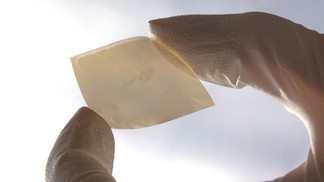A new method for cheaper solar-energy storage
Last edited Wed Jul 1, 2015, 11:11 AM - Edit history (1)
http://actu.epfl.ch/news/a-new-method-for-cheaper-solar-energy-storage-2/[font face=Serif][font size=5]A new method for cheaper solar-energy storage[/font]
[font size=4]
01.07.15 - Building on a unique idea, EPFL scientists have developed a cost-effective new method for converting and storing solar energy into hydrogen.[/font]

A tungsten diselinide thin-film ©Kevin Sivula/EPFL
[font size=3]Storing solar energy as hydrogen is a promising way for developing comprehensive renewable energy systems. To accomplish this, traditional solar panels can be used to generate an electrical current that splits water molecules into oxygen and hydrogen, the latter being considered a form of solar fuel. However, the cost of producing efficient solar panels makes water-splitting technologies too expensive to commercialize. EPFL scientists have now developed a simple, unconventional method to fabricate high-quality, efficient solar panels for direct solar hydrogen production with low cost. The work is published in
Nature Communications.
…
Kevin Sivula and colleagues at EPFL addressed this problem with an innovative and cheap method that uses the boundary between two non-mixing liquids. The researchers focused on one of the best 2-D materials for solar water splitting, called “tungsten diselenide”. Past studies have shown that this material has a great efficiency for converting solar energy directly into hydrogen fuel while also being highly stable.
Before making a thin film of it, the scientists first had to achieve an even dispersion of the material. To do this, they mixed the tungsten diselenide powder with a liquid solvent using sonic vibrations to “exfoliate” it into thin, 2-D flakes, and then added special chemicals to stabilize the mix. Developed by Sivula’s lab (2014), this technique produces an even dispersion of the flakes that is similar to an ink or a paint.
The researchers then used an out-of-the-box innovation to produce high-quality thin films: they injected the tungsten diselenide ink at the boundary between two liquids that do not mix. Exploiting this oil-and-water effect, they used the interface of the two liquids as a “rolling pin” that forced the 2-D flakes to form an even and high-quality thin film with minimal clumping and restacking. The liquids were then carefully removed and the thin film was transferred to a flexible plastic support, which is much less expensive than a traditional solar panel.
…[/font][/font]
